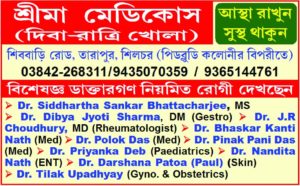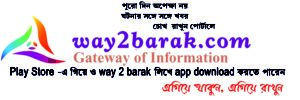Barak UpdatesHappenings
ক্লু মিলেছে, ট্রিপারচালক শীঘ্র ধরা পড়বে, বললেন এসপিClue found, tipper driver will be nabbed soon, says SP Cachar
পিকেটারদের বিরুদ্ধে একাধিক মামলাMultiple cases against picketers

৩১ জুলাইঃ চিত্র সাংবাদিক মলিন শর্মার ঘাতক ট্রিপারটিকে চিহ্নিত করা শুধু সময়ের অপেক্ষা। পর্যাপ্ত ক্লু পুলিশের হাতে এসে পড়েছে। শীঘ্র গ্রেফতার করা হবে এর চালককে। বুধবার সাংবাদিকদের এ কথা জানিয়েছেন পুলিশ সুপার মুগ্ধজ্যোতি দেব মহন্ত। তিনি মলিনের মৃত্যু ও এর পরবর্তী ঘটনাপ্রবাহে পুলিশের গাফিলতির দায় স্বীকার করে নেন। সোজাসুজি বলেন, আমি ক্ষমাপ্রার্থী।
 পরে আলাপচারিতায় তিনি সাংবাদিকদের পরামর্শ চান। তাঁদের দাবি মেনে নিয়ে দেবমহন্ত জানান, অজ্ঞাতপরিচয় ট্রিপারচালকের বিরুদ্ধে পুলিশ নিজেরাই হত্যার মামলা দায়ের করেছে। এ দিনের আলোচনায় অতিরিক্ত পুলিশ সুপার জগদীশ দাস ছাড়াও ডেপুটি পুলিশ সুপার উপস্থিত ছিলেন।
পরে আলাপচারিতায় তিনি সাংবাদিকদের পরামর্শ চান। তাঁদের দাবি মেনে নিয়ে দেবমহন্ত জানান, অজ্ঞাতপরিচয় ট্রিপারচালকের বিরুদ্ধে পুলিশ নিজেরাই হত্যার মামলা দায়ের করেছে। এ দিনের আলোচনায় অতিরিক্ত পুলিশ সুপার জগদীশ দাস ছাড়াও ডেপুটি পুলিশ সুপার উপস্থিত ছিলেন।
 এ দিকে, মলিন শর্মার মৃত্যুর প্রেক্ষিতে পথ নিরাপত্তার দাবিতে মঙ্গলবার যারা বনধ ডেকেছিলেন, তাঁদের বিরুদ্ধে একটি মামলা দায়ের করা হয়েছে। পুলিশর টাউন সাব-ইন্সপেক্টর (টিএসআই) তাতে উল্লেখ করেন, বনধ ডাকা বেআইনি। তা জেনেও এরা বনধের ডাক দিয়েছেন। অন্যদিকে, বিচার বিভাগ থেকে দুটি পৃথক মামলা হয়েছে। অতিরিক্ত চিফ জুডিশিয়াল ম্যাজিস্ট্রেট অভিযোগ করেছেন, একদল পিকেটার তাঁর অফিসে ঢুকে কাজে বিঘ্ন ঘটায়। অন্য তিন বিচারকের মামলায় বলা হয়েছে, পিকেটাররা তাদের পথে বাধা দান করেছে। জেলাশাসকের অফিসের সামনে পুলিশের সঙ্গে দুর্ব্যবহারের অভিযোগও তোলা হয়েছে। সমস্ত অভিযোগের প্রেক্ষিতে দোষীদের শনাক্ত করার কাজ চলছে। পুলিশ সুপার জানান, বিভিন্ন জায়গায় সিসিটিভি-র ফুটেজ সংগ্রহ করা হয়েছে। সেগুলি এখন খতিয়ে দেখা হচ্ছে।
এ দিকে, মলিন শর্মার মৃত্যুর প্রেক্ষিতে পথ নিরাপত্তার দাবিতে মঙ্গলবার যারা বনধ ডেকেছিলেন, তাঁদের বিরুদ্ধে একটি মামলা দায়ের করা হয়েছে। পুলিশর টাউন সাব-ইন্সপেক্টর (টিএসআই) তাতে উল্লেখ করেন, বনধ ডাকা বেআইনি। তা জেনেও এরা বনধের ডাক দিয়েছেন। অন্যদিকে, বিচার বিভাগ থেকে দুটি পৃথক মামলা হয়েছে। অতিরিক্ত চিফ জুডিশিয়াল ম্যাজিস্ট্রেট অভিযোগ করেছেন, একদল পিকেটার তাঁর অফিসে ঢুকে কাজে বিঘ্ন ঘটায়। অন্য তিন বিচারকের মামলায় বলা হয়েছে, পিকেটাররা তাদের পথে বাধা দান করেছে। জেলাশাসকের অফিসের সামনে পুলিশের সঙ্গে দুর্ব্যবহারের অভিযোগও তোলা হয়েছে। সমস্ত অভিযোগের প্রেক্ষিতে দোষীদের শনাক্ত করার কাজ চলছে। পুলিশ সুপার জানান, বিভিন্ন জায়গায় সিসিটিভি-র ফুটেজ সংগ্রহ করা হয়েছে। সেগুলি এখন খতিয়ে দেখা হচ্ছে।



